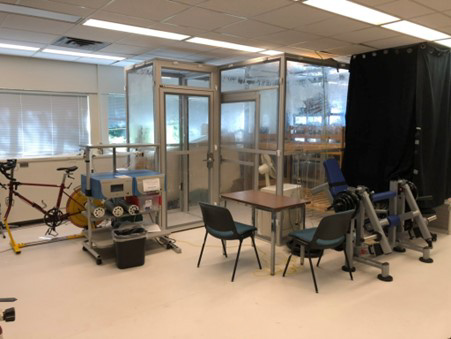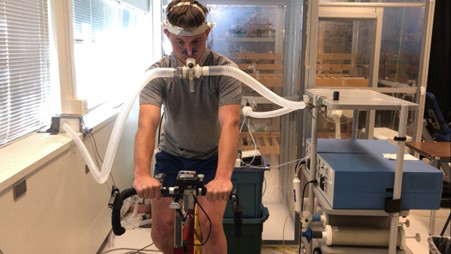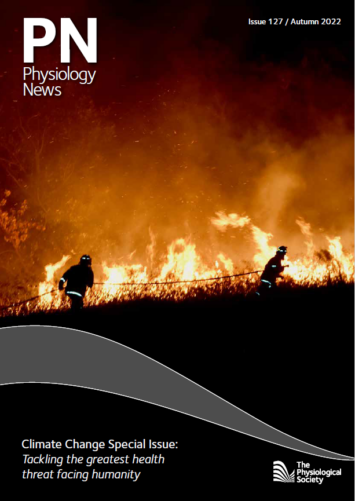
Physiology News Magazine
How does air pollution affect our health?
Exploring the health impacts associated with short- and long-term exposure to air pollutants
Features
How does air pollution affect our health?
Exploring the health impacts associated with short- and long-term exposure to air pollutants
Features

https://doi.org/10.36866/pn.127.26
Dr Michael Koehle
University of British Columbia, Canada
Since The Physiological Society is devoting this themed issue to climate change, one might wonder what air pollution has to do with climate change? Although air pollution comprises a complex mixture of both gases and particles, the primary gaseous air pollutants (e.g. ozone, oxides of nitrogen) are not the same as the primary greenhouse gases (e.g. carbon dioxide, methane) responsible for climate change. However, air pollution is both a cause and a result of climate change.
More frequent and severe heat events and wildfires directly lead to air pollution in the form of particulates from wildfires and ozone generated during heat events. Furthermore, black carbon generated from industry, internal combustion and fires contributes directly to climate change through absorption of heat by black carbon particles in the atmosphere, and by reduced light reflectance of ice and snow by this black carbon, further aggravating temperature increases. As such, we can expect a worsening of air pollution because of climate change, and an acceleration of climate change because of air pollution.
Air pollution has a significant negative effect on our health. It is the leading environmental cause of mortality, and contributes to cardiovascular disease, respiratory disease, diabetes, stroke, and dementia. Children exposed to higher levels of ozone are more likely to develop asthma later in life. With 99% of the world’s population living in areas that exceed World Health Organization recommended safe levels of air pollution, we can expect an increasing health toll in terms of the negative effects of air pollution.
As physiologists, what can we do to mitigate these negative health effects? A few things.
Is it safe to exercise in poor air quality?
The pathophysiology of air pollution is still poorly understood. Air pollution is a complex recipe of gases and particles that varies by location, season, weather, and time of day. These varying recipes can have different physiological and pathophysiological consequences. Exposure studies in a variety of conditions with healthy and clinical populations are an important means to investigate these interactions. Furthermore, many air pollution countermeasures have been proposed, such as mask wearing, nutritional interventions, and even medications. These require further evaluation to assess their efficacy and tolerability.
One focus of our laboratory is the interaction between exercise and air pollution (Fig.1). Exercise is a proven tool to prevent and treat many conditions (including the cardiovascular disease, respiratory disease, diabetes, stroke, and dementia mentioned earlier). However, there has always been the concern that exercise may worsen the effects of air pollution. This concern comes from the fact that, by definition, exercise leads to an increase in metabolic rate, and therefore lung ventilation, which can increase the inhaled dose of air pollutants. Furthermore, as exercise gets more intense, we tend to breathe more through our mouths and less through our noses. Since the nasal passages act as natural filtration systems, more intense exercise can theoretically lead to an even higher inhaled dose of air pollution (Giles and Koehle, 2014). These potential concerns have led to very mixed messaging for active individuals, uncertain as to whether they should exercise when air quality is poor.

Why it is important to keep active?
When messaging to the public is conflicting, often it means that good-quality research is lacking. Therefore, for the past 10 years, we have been studying the interaction between air pollution and exercise using both laboratory-controlled air pollution exposures and field studies in ambient, polluted air.
We have explored the fundamental question of “Does exercising in air pollution exacerbate the negative effects of air pollution?”, and have also explored other questions such as: “Do medications exacerbate or help symptoms when exercising in air pollution? Can we adapt to air pollution? What are the effects of pollution exposure before exercise? How does exercise intensity influence the effects of air pollution on the body?” (Figs. 2 & 3).
What we are learning is that although air pollution can lead to the many diseases mentioned above, doing exercise does not make these effects worse (Giles and Koehle, 2014; Sun et al., 2019; Andersen et al., 2015). At most, for certain conditions (e.g. dementia), it appears that air pollution might diminish or obscure the beneficial effects of exercise (Raichlen et al., 2022). On the whole, it seems clear that although air pollution has many negative effects, we do not need to avoid exercise during prolonged periods of poor air quality. In fact, decreasing physical activity in response to poor air quality can lead to a synergistic epidemic (termed syndemic”) combining the negative effects of sedentary behaviour with the consequences of air pollution (Ding and Elbarbary, 2021).

When and what type of exercise to undertake in poor air quality?
We therefore advise individuals that air pollution is bad for our health 24 hours per day. We should do everything we can to reduce our personal exposure to air pollution as much as possible. Everything except stopping exercising. For example, choosing to exercise in the early mornings, when both ground-level ozone and particulate matter levels are often at their lowest, can minimise the pollution dose. Furthermore, distancing the location of exercise away from pollution sources (such as busy roads) dramatically reduces the impact of pollution. A nice rule of thumb is that 400 metres from a source, pollution levels decrease to the background levels for the area. For individuals, this might mean exercising closer to the centre of a park, and not right next to a roadway.
Are there forms of exercise that are better to undertake in poor quality air? Probably. Very prolonged exercise (>90 minutes) has not been adequately studied but could lead to a very high dose of inhaled pollutants, thus having the potential for greater effects. Conversely, from acute exposure studies, we have learned that shorter, higher-intensity exercise seems to be well-tolerated (Giles et al., 2014). We have also learned that medications (e.g. asthma medications) that open up the airway (and theoretically increase the dose of pollution) do not make symptoms worse in humans (Koch et al., 2021; Stothers et al., 2022). Therefore, individuals with asthma or exercise-induced bronchoconstriction are advised to continue taking their medications as prescribed by their physicians.

Can we adapt to air pollution?
What areas need more research? Masks, nutritional supplements and adaptation to name a few. We know that high-quality masks can reduce the intake of certain pollutants (especially particulate matter), but research is lacking around their utility and efficacy during exercise and in high pollution. There is evidence that some supplements (e.g. vitamins C and E) may be efficacious against certain pollutants (e.g. ozone), but more work needs to be done to optimise dosage and preparations.
Adaptation is a key strategy for humankind with the climate emergency. Interestingly, there is even evidence that we may be able to adapt to certain pollutants, especially ground level ozone (Sandford et al., 2021; Foxcroft and Adams, 1986). We need to understand how effective this potential adaptation may be, and under what circumstances, and in what populations.
One area where physiologists are increasingly playing an important role is in sport. Ever more frequently, I see high-performance teams considering air pollution exposure as a health and performance factor in the lead-up to important events. For example, in Canada’s recent successful campaign to qualify for the 2022 football World Cup Finals, they engaged physiologists to advise on air pollution mitigation during important matches held under polluted conditions. Likewise, in the preparation for the Tokyo Olympics, not only were the high ozone levels a consideration for teams and athletes (especially in the distance events), athletes adjusted their pre-competition training times and locations to minimise pollution exposure during training camps. With upcoming Summer Olympic Games in Paris and Los Angeles, we can expect that not only heat, but polluted air will be a factor for the athletes to contend with.
In summary, air pollution is becoming an increasingly important issue in conjunction with climate change. Developing strategies to mitigate the adverse effects of air pollution while promoting healthy physical activity is crucial for preventing a syndemic of air pollution and inactivity.
References
Andersen ZJ et al. (2015). A study of the combined effects of physical activity and air pollution on mortality in elderly urban residents: the Danish diet, cancer, and health cohort. Environmental Health Perspectives 123(6), 557–563. https://doi.org/10.1289/ehp.1408698
Ding D, Elbarbary M (2021). Addressing the syndemics of physical inactivity and air pollution. Canadian Medical Association Journal 193(32), E1255–E1256. https://doi.org/10.1503/cmaj.211282
Foxcroft WJ, Adams WC (1986). Effects of ozone exposure on four consecutive days on work performance and VO2(max). Journal of Applied Physiology 61(3), 960–966. https://doi.org/10.1152/jappl.1986.61.3.960
Giles LV et al. (2014). Physiological responses to diesel exhaust exposure are modified by cycling intensity. Medicine & Science in Sports & Exercise 46(10), 1999–2006. https://doi.org/10.1249/MSS.0000000000000309
Giles LV, Koehle MS. (2014). The health effects of exercising in air pollution. Sports Medicine 44(2), 223–249. https://doi.org/10.1007/s40279013-0108-z
Koch, S et al. (2021). Ventilatory responses to constant load exercise following the inhalation of a short-acting ß2-agonist in a laboratory controlled diesel exhaust exposure study in individuals with exercise-induced bronchoconstriction. Environment International 146, 106182. https://doi.org/10.1016/j.envint.2020.106182
Raichlen, DA et al. (2022). Association of physical activity with incidence of dementia is attenuated by air pollution. Medicine and Science in Sports and Exercise 54(7), 1131–1138. https://doi.org/10.1249/MSS.0000000000002888
Sandford GN et al. (2021). Ozone pollution: A “hidden” environmental layer for athletes preparing for the Tokyo 2020 Olympics & Paralympics. British Journal of Sports Medicine 55(4) p.189–190. https://doi.org/10.1136/bjsports-2020-103360
Stothers B et al. (2022). Examining the Effect of Salbutamol Use in Ozone Air Pollution by People with Asthma and/or Exercise Induced Bronchoconstriction. M.Sc. thesis. Vancouver: University of British Columbia. https://doi.org/10.14288/1.0416295
Sun S et al. (2019). Benefits of physical activity not affected by air pollution: a prospective cohort study. International Journal of Epidemiology 1; 49(1): 142- 152. https://doi.org/10.1093/ije/dyz184
